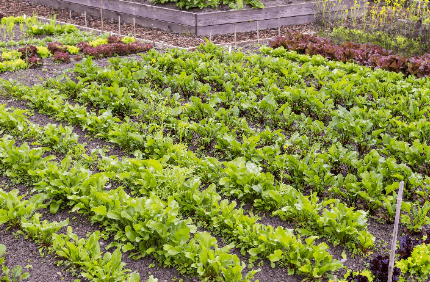No-dig gardening is a farming practice that uses organic materials from seed without digging and turning the soil as in traditional farming. This technique reduces soil erosion, and it’s good for the soil’s health, nature, and environment. The main principle of no-dig gardening is to avoid digging the soil, and to nourish the soil directly from the top with usable organic matter.
In traditional gardening practices in our country, the land is dug and turned several times a year, resulting in soil degradation. This process leads to the death of beneficial bacteria and organisms crucial for soil health. The notable advantage of no-dig gardening is that it avoids harm to these bacteria and organisms present in the soil. This method involves creating layers on top of the existing soil, thus preserving the natural organisms within these layers. The layers include a compost layer, a mulch layer, and a layer of newspaper or cardboard.
No-dig gardening is a sustainable and environment-friendly farming practice that provides less labour and more natural and healthy soil compared to traditional gardening. It is suitable even for beginning gardeners and its effect lasts for a long time.
Step 1: Choose the right location
Selecting a suitable location is important for successful no-dig gardening. Choose a location with adequate sunlight, good ventilation and proper drainage. The area you select should be free from constantly growing weeds and have a level surface.
Step 2: Prepare the Ground
Layering requires you to prepare the ground by removing existing grass or weeds. Here place a thin layer of newspaper or cardboard directly on the ground. It prevents weed growth by acting as a barrier.
Apart from this it encourages the activity of beneficial bacteria and earthworms.
Step 3: Add Fertilizer
Now apply a generous layer of nutrient-rich compost on newspaper or cardboard. This layer of compost acts as an essential source of nutrition for plants and enhances the structure of the soil. Spread the compost evenly over the entire gardening area.
Step 4: Add a layer of organic mulch
Now add a layer of organic mulch such as straw, wood chips, or shredded leaves on top of the compost layer. This mulch not only helps retain moisture, prevent weed growth but also helps in creating a favorable environment for beneficial microorganisms.
Step 5: Create the Planting Beds
Shape the layers of compost and mulch into raised planting beds. These beds provide elevated planting spaces, better drainage, and improved aeration. The dimensions of the planting beds may vary depending on your preference and available space.
Step 6: Planting
You can now plant directly into the beds without digging. Drill holes through the layers of mulch and compost to reach the soil beneath. Insert the plants into these holes, ensuring they are planted at the proper depth. Thoroughly water the newly planted plants.
Step 7: Watering and Maintenance
Regularly water your no-dig garden to maintain optimal moisture levels. The layers of compost and mulch assist in retaining water, reducing the frequency of watering. Additionally, monitor for any signs of weeds and remove them as needed.
Step 8: Add a fresh layer of organic mulch
Periodically add a fresh layer of organic mulch over the existing mulch. This helps in maintaining moisture, regulating soil temperature, and preventing weed growth. Mulch also decomposes slowly, contributing to the improvement of soil structure.
Step 9: Observing Growth
As your plants grow, observe their progress and address any specific needs they may have. Gardening without digging provides a favorable environment for plant growth, and you will see healthier, more vibrant growth compared to traditional gardening methods.
Step 10: Continuous Improvement
Gardening without digging is an ongoing process of improvement. Over time, the layers will break down, and the soil structure will improve. You can add more compost and mulch as needed to replenish nutrients and enhance the overall health of the garden.
Step 11: Harvesting
When your plants reach maturity, harvest them and enjoy the fruits or vegetables of your labor. Gardening without digging produces nutrient-dense crops, and the flavors are often enhanced due to the enriched soil.
Step 12: Crop Rotation Is Important
Consider practicing crop rotation in subsequent seasons to maintain soil fertility and prevent the buildup of pests and diseases. Move different plant varieties to new areas within the no-dig beds to promote overall garden health.


